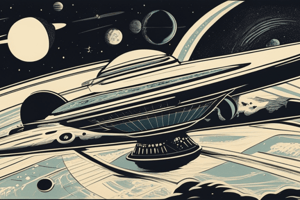Podcast
Questions and Answers
What is the smallest and closest planet to the Sun?
What is the smallest and closest planet to the Sun?
Mercury
Which planet is known for its Great Red Spot and numerous moons?
Which planet is known for its Great Red Spot and numerous moons?
Jupiter
Which planet is famous for its ring system and moons like Titan?
Which planet is famous for its ring system and moons like Titan?
Saturn
Which planet is our home planet with liquid water and a diverse range of life?
Which planet is our home planet with liquid water and a diverse range of life?
Which planet is the farthest from the Sun and has the highest winds in the solar system?
Which planet is the farthest from the Sun and has the highest winds in the solar system?
Name one of the officially recognized dwarf planets in our solar system.
Name one of the officially recognized dwarf planets in our solar system.
What are the inner planets primarily composed of?
What are the inner planets primarily composed of?
What are the outer planets primarily composed of?
What are the outer planets primarily composed of?
Which spacecraft provided detailed data about Mercury's surface and composition?
Which spacecraft provided detailed data about Mercury's surface and composition?
What spacecraft mapped Venus' surface in the 1990s?
What spacecraft mapped Venus' surface in the 1990s?
Which planet was studied by the Mars rovers Spirit, Opportunity, Curiosity, and Perseverance?
Which planet was studied by the Mars rovers Spirit, Opportunity, Curiosity, and Perseverance?
What spacecraft orbited Jupiter from 1995 to 2003?
What spacecraft orbited Jupiter from 1995 to 2003?
Study Notes
Planets: Classification, Solar System, and Exploration
Our solar system is home to a diverse collection of celestial bodies, known as planets. These planets are divided into two primary categories: inner planets and outer planets. The inner planets are rocky and have solid surfaces, while the outer planets are larger and primarily composed of gas and ice.
The eight planets in our solar system, moving outward from the Sun, are:
- Mercury: The smallest and closest planet to the Sun.
- Venus: Our sister planet, with a thick atmosphere and extreme temperatures.
- Earth: Our home planet, with liquid water and a diverse range of life.
- Mars: The red planet, with evidence of ancient water and potentially current underground reservoirs.
- Jupiter: The largest planet in our solar system, known for its Great Red Spot and numerous moons.
- Saturn: Famous for its ring system and numerous moons, including Titan.
- Uranus: A gas giant with a unique tilt, causing extreme seasons.
- Neptune: The farthest planet from the Sun, with the highest winds in the solar system.
In addition to these planets, there are five officially recognized dwarf planets in our solar system. These are Ceres, Pluto, Haumea, Makemake, and Eris.
The solar system can be divided into three regions:
- Inner Solar System: This region is home to the four inner planets, Mercury, Venus, Earth, and Mars, as well as numerous asteroids and comets.
- Outer Solar System: This region is dominated by the four gas giants - Jupiter, Saturn, Uranus, and Neptune - and their numerous moons.
- Kuiper Belt and Oort Cloud: These are distant, icy regions containing countless dwarf planets and other small bodies.
Planet Classification
Planets are classified based on their composition and size. The inner planets, also known as terrestrial planets, are primarily composed of rock and metal, and are relatively small in size. The outer planets, or gas giants, are primarily composed of gas and ice, and are much larger.
Solar System
Our solar system is a part of the Milky Way galaxy, located in the Orion Arm. It is composed of a central star, the Sun, and its eight planets, five dwarf planets, and numerous other celestial bodies.
Planet Exploration
Exploration of planets is a crucial part of our understanding of the universe. Spacecraft have provided detailed information about these celestial bodies, allowing us to study their composition, geology, and atmospheres. For example:
- Mercury: NASA's Messenger spacecraft orbited Mercury from 2011 to 2015, providing detailed data about its surface and composition.
- Venus: The Magellan spacecraft mapped Venus' surface in the 1990s, revealing a world covered in volcanic features.
- Earth: Earth is the only planet we currently inhabit, and we continue to explore it through satellites, ground-based research, and spacecraft like the International Space Station.
- Mars: Mars rovers, such as Spirit, Opportunity, Curiosity, and Perseverance, have studied the planet's geology, climate, and potential for past life.
- Jupiter: The Galileo spacecraft orbited Jupiter from 1995 to 2003, providing detailed information about its moons and atmosphere.
- Saturn: The Cassini-Huygens mission, which ended in 2017, provided detailed information about Saturn's rings and moons.
- Uranus: The Voyager 2 mission provided the first detailed images of Uranus in 1986.
- Neptune: The Voyager 2 mission also provided the first detailed images of Neptune in 1989.
In conclusion, planets play a vital role in our understanding of the solar system and the universe as a whole. Their exploration has led to significant scientific advancements and continues to inspire our quest for knowledge about the cosmos.
Studying That Suits You
Use AI to generate personalized quizzes and flashcards to suit your learning preferences.
Description
Explore the classification of planets in our solar system, learn about the inner and outer planets, and delve into the exploration of celestial bodies through spacecraft missions. From Mercury to Neptune, understand the composition, characteristics, and significance of each planet.




